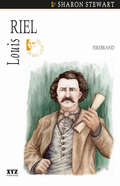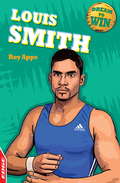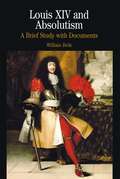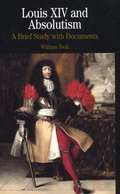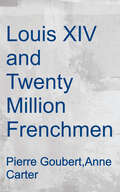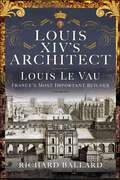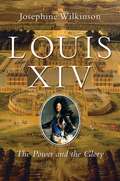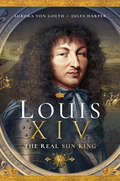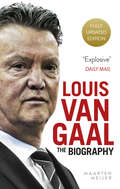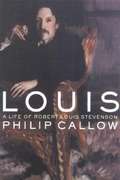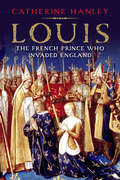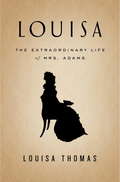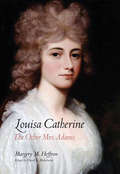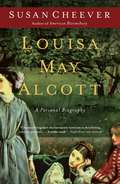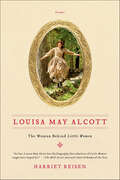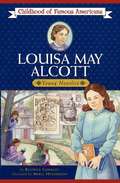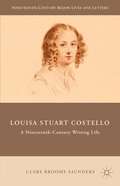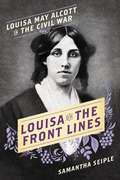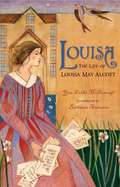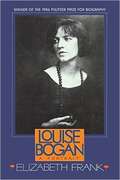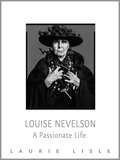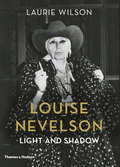- Table View
- List View
Louis Riel: Firebrand
by Sharon StewartLouis Riel devoted his life to the Metis cause. A fiery activist, he struggled against injustice as he saw it. He was a pioneer in the field of Aboriginal rights and land claims but was branded an outlaw in his own time. In 1885, he was executed for treason. In 1992, the House of Commons declared Riel a founder of Manitoba. November 16 is now designated Louis Riel Day in Canada.
Louis Smith: Louis Smith (EDGE: Dream to Win #16)
by Roy AppsWhen Louis Smith was seven he was faced with a choice that would change the course of his whole life. He chose the path of an athlete, but he lacked concentration and was easily distracted. As a punishment his coach made him perform circles on the pommel horse...Dream to Win: Louis Smith is written by expert author Roy Apps for kids with a reading age of 7 (but could also be enjoyed by pre-teens) and illustrated with black-and-white artwork. The stories focus on top athletes and sport personalities, with each dramatic story bringing to life the skill, determination and luck needed to break through into top level competition.This title is published by Franklin Watts EDGE, which produces a range of booksto get children reading with confidence. EDGE - for books children can't put down.
Louis XIII, The Just
by A. Lloyd MooteIn this fascinating biography, A. Lloyd Moote provides the first authoritative account of one of the most enigmatic figures of seventeenth-century Europe. Contrary to popular portrayals of the monarch as a hapless King, Moote argues that Louis XIII was a ruler who powerfully shaped his people's destiny.
Louis XIV and Absolutism: A Brief Study With Documents (The Bedford Series In History And Culture)
by William BeikThis unique collection of documents with commentary explores the meaning of absolute monarchy by examining how Louis XIV of France became one of Europe’s most famous and successful rulers. In the introduction, William Beik succinctly integrates the theoretical and practical nature of absolutism and its implications for the development of European states and society. <P><P>The documents, newly translated and carefully selected for their readability, examine the problems of the Fronde, Colbert’s grasp of the economic and fiscal dimensions of the kingdom, the taming of the rural nobility, the interaction of royal ministers and provincial authorities, the repression of Jansenists and Protestants, popular rebellions, and royal image-making. Explanatory notes, a chronology, a map, a geneaology chart, and 9 striking images further strengthen this volume’s usefulness in the undergraduate classroom.
Louis XIV and Absolutism: A Brief Study with Documents (A Bedford Series in History and Culture)
by William BeikThis unique collection of documents with commentary explores the meaning of absolute monarchy by examining how Louis XIV of France became one of Europe's most famous and successful rulers. In the introduction, William Beik succinctly integrates the theoretical and practical nature of absolutism and its implications for the development of European states and society.
Louis XIV and Twenty-Million Frenchmen: A New Approach: Exploring The Interrelationship Between the People of a Country and the Power of its King
by Pierre GoubertLouis XIV is one of history’s most notorious rulers. Ruling for three quarters of a century, the King of France had the longest reign in European history, and the effects of his rule would create the conditions that would lead to the French Revolution. Written by an authority on 17th century Europe, Pierre Goubert not only outlines the life the famous “Sun King." but the millions of subjects under his rule, and the effects his choices had on the them.
Louis XIV's Architect: Louis Le Vau, France's Most Important Builder
by Richard BallardA must-read for those seeking to understand the intersection of politics and art in a pivotal moment of European history. This is a study of royal absolutism in a most extreme form in modern European history, and of the nature of Louis XIV's concept of personal glory and of the embodiment of France as a new superpower. It is a study of political ideas expressed in architecture to establish Versailles as the centre of French world power and royal prestige. It is also a personal story, full of social, cultural, and economic history of the period as seen in the life and work of Louis Le Vau, from a humble family of craftsmen, who was a self-taught architect in the early history of the profession, skilled in technical craft skills and even grand design. He was a major contributor to the architectural glories of Paris including the Louvre, Vincennes, Versailles and the College of the Four Nations. And all achieved despite interference from the great magnates of the age like Mazarin and Colbert and constant mind-changing by the King who wanted every feature in the buildings to reflect his concept of personal, royal, prestige. Le Vau was Louis XIV's First Architect from 1654 until his death and disgrace in 1670. The social, cultural, economic and political backdrop is striking with court intrigue, scandal, corruption, luxury, indulgence and the rise of a rich bourgeoisie, but the main thrust of the story concerns Louis XIV and the royal personal ambition, and the work of a stone-cutter's son who became the Sun King's instrument. The study is good on the more technical features of architectural history - reminiscent of Pevsner's marvellous Buildings of England series.
Louis XIV: The Gift From God
by Josephine WilkinsonAn intelligent, authoritative, and often surprising biography of the most famous of French monarchs, by an acclaimed biographer and historian. This stylish and incisive narrative presents readers with a fresh perspective on one of the most fascinating kings in European history. Louis XIV’s story has all the ingredients of a Dumas classic: legendary beginnings, beguiling women, court intrigue, a mysterious prisoner in an iron mask, lavish court entertainments, the scandal of a mistress who was immersed in the dark arts, and a central character who is handsome and romantic, but with a frighteningly dark side to his character. Louis believed himself to be semi-divine. His self-identification as the Sun King, which was reflected in iconography by the sun god, Apollo, influenced every aspect of Louis’s life: his political philosophy, his wars, and his relationships with courtiers and subjects. As a military strategist, Louis’s capacity was ambiguous, but he was an astute politician who led his country to the heights of sophistication and power—and then had the misfortune to live long enough to see it all crumble away. As the sun began to set upon this most glorious of reigns, it brought a gathering darkness filled with the anguish of dead heirs, threatened borders, and a populace that was dangerously dependent upon—but greatly distanced from—its king.
Louis XIV: The Real Sun King
by Jules Harper Aurora von GoethA concise, straightforward biography of the seventeenth-century French monarch and his seventy-two-year reign. Innovator. Tyrant. Consummate showman. Passionate lover of women. After the death of King Louis XIII in 1643, the French crown went to his first-born son and heir, four-year old Louis XIV. In the extraordinary seventy-two years that followed, Louis le Grand—France&’s self-styled &“Sun King&”—ruled France and its people, leaving his unique and permanent mark on history and shaping fashion, art, culture and architecture like none other before. This frank and concise book gives the reader a personal glimpse into the Sun King&’s life and times as we follow his rise in power and influence: from a miraculous royal birth no one ever expected to the rise of king as absolute monarch, through the evolution of the glittering Château de Versailles, scandals and poison, four wars and many more mistresses . . . right up to his final days. Absolute monarch. Appointed by God. This is Louis XIV, the man. We will uncover his glorious and not-so-glorious obsessions. His debilitating health issues. His drive and passions. And we will dispel some myths, plus reveal the people in his intimate circle working behind the scenes on the Louis propaganda machine to ensure his legacy stayed in the history books forever. This easy-to-read narrative is accompanied by a plethora of little-known artworks, so if you&’re a Louis XIV fan or student, or just eager to know more about France&’s most famous king, we invite you to delve into court life of seventeenth-century French aristocracy, the period known as Le Grand Siècle—&“The Grand Century.&”
Louis van Gaal: The Biography
by Maarten MeijerSo who is Louis van Gaal? An inflexible ex-PE teacher who only knows how to act like a dictator or a footballing visionary that has made him one of the greatest ever European managers? Wherever he has gone, Van Gaal has been accused of being a domineering disciplinarian and a control freak. He is certainly, by his own admission, a man who leaves nothing to chance. A disciple in the 1970s of Rinus Michels’ Total Football philosophy, he is a fascinating contradiction – an ultra-individualist utterly devoted to the collective effort. He believes in the team over the individual, in always having a plan and a team prepared to follow it. Van Gaal led the young Ajax team he moulded to Champions League glory in 1995, went on to win titles across Europe with Barcelona, AZ Alkmaar and Bayern Munich and served two stints as national coach of Holland. It is a career that has never been short on colour and drama – from fallouts with players to rants at the media wherever he has managed. Dutch football commentator Maarten Meijer’s has written the definitive biography of van Gaal – both the man and his methods. It offers the best psychological insight so far – from his earliest roots to his greatest triumphs – into the man given the task of returning the glory days to Manchester United.**New chapter on Louis van Gaal's first season with Manchester United**
Louis: A Life of Robert Louis Stevenson
by Philip CallowThere are many Stevensons behind the initials RLS, but the one that has endeared him to readers for so long is surely the fighter, battling to stay alive. Jorge Luis Borges described his brief life as courageous and heroic. In Philip Callow s absorbing new biography, one can see why. Doctors, called repeatedly to what should have been his deathbed, would find a scarecrow, twitching and alive. A sickly child, Louis became in turn a bohemian dandy, a literary gypsy traipsing through the mountains of France with a donkey, and at twenty-eight the lover of an American woman ten years his senior, the fabulous Fanny. He escaped his Scottish town, his family, his friends who had mapped out a literary career for him in London, and instead went chaotically across the Atlantic and overland to California in poverty and despair to reach his beloved, whereupon he escaped into marriage and committed himself to being a nomad. He sailed the Pacific and dreamed of being an explorer; his restlessness was Victorian. With the power of a novelist and the grace of a poet (of which he is both), Philip Callow captures this great writer and his many contradictions. He was a born exile longing for home; a northerner who thrived on tropic sunshine; a near atheist who organized Sunday services for his Samoan workers. He has been called Scotland's finest writer of English prose, a more economical Walter Scott. As an essayist he equaled Hazlitt. In emotional crises he wept openly, to the embarrassment of his wife. His feelings are always his reasons, said Henry James, and caught in a sentence the secret of Stevenson s popularity as one of the last of the classic storytellers. Louis brings him alive. With 8 pages of black-and-white photographs. "
Louis: My Story So Far
by Louis SmithIn 2008, Louis Smith was the first Briton in over 100 years to win an Olympic medal in individual gymnastics. In 2012 he followed up that triumph with two more. Since then, Louis has been crowned the winner of STRICTLY COME DANCING with his partner Flavia and he is now setting his sights on designing his own clothing range. Now you can follow him backstage to see what it is like to be one of the UK's hottest new stars.Louis was brought up by his mum in Peterborough and ever since he could walk he wanted to run. He was diagnosed with ADHD and needed a positive outlet for his energy so on his fourth birthday he began gymnastics classes. His strength, flexibility and talent were spotted almost immediately and so began the early starts, the late finishes and the weekends spent in the gym. Louis won his first medal at 14 and all the hard work and financial sacrifice were put into perspective. Louis wanted to win and represent his country at the Olympics. From that point, there was no looking back.Here, in his own official book, Louis tells the story of his amazing journey in full. Beautifully designed and jam packed full of exclusive unseen photos of Louis on and off the gymnastics and dance floors, plus private captured moments, the incredible story of Louis's rise to fame is a must-have for any true fan and the perfect gift for Christmas.
Louis: The French Prince Who Invaded England
by Catherine HanleyIn 1215 a group of English barons, dissatisfied with the weak and despicable King John, decided that they needed a new monarch. They wanted a strong, experienced man, of royal blood, and they found him on the other side of the Channel: astonishingly, the most attractive candidate for the crown of England was Louis, eldest son and heir of the king of France. In this fascinating biography of England's least-known "king"--and the first to be written in English--Catherine Hanley explores the life and times of "Louis the Lion" before, during, and beyond his quest for the English throne. She illuminates the national and international context of his 1216 invasion, and explains why and how after sixteen fruitless months he failed to make himself King Louis I of England. Hanley also explores Louis's subsequent reign over France until his untimely death on the Albigensian Crusade. Published eight centuries after the creation of Magna Carta and on the 800th anniversary of Louis's proclamation as king, this fascinating story is a colorful tale of national culture, power, and politics that brings a long-forgotten life out of the shadows of history.
Louisa
by Louisa ThomasAn intimate portrait of Louisa Catherine Adams, the wife of John Quincy Adams, who witnessed firsthand the greatest transformations of her time Born in London to an American father and a British mother on the eve of the Revolutionary War, Louisa Catherine Johnson was raised in circumstances very different from the New England upbringing of the future president John Quincy Adams, whose life had been dedicated to public service from the earliest age. And yet John Quincy fell in love with her, almost despite himself. Their often tempestuous but deeply close marriage lasted half a century. They lived in Prussia, Massachusetts, Washington, Russia, and England, at royal courts, on farms, in cities, and in the White House. Louisa saw more of Europe and America than nearly any other woman of her time. But wherever she lived, she was always pressing her nose against the glass, not quite sure whether she was looking in or out. The other members of the Adams family could take their identity for granted--they were Adamses; they were Americans--but she had to invent her own. The story of Louisa Catherine Adams is one of a woman who forged a sense of self. As the country her husband led found its place in the world, she found a voice. That voice resonates still. In this deeply felt biography, the talented journalist and historian Louisa Thomas finally gives Louisa Catherine Adams's full extraordinary life its due. An intimate portrait of a remarkable woman, a complicated marriage, and a pivotal historical moment, Louisa Thomas's biography is a masterful work from an elegant storyteller.From the Hardcover edition.
Louisa Catherine: The Other Mrs. Adams
by Margery M. Heffron&“Spiced with sexual mischief, political conflict and family tragedy . . . Her biography is nothing less than captivating, an engrossing read.&”—Pittsburgh Post-Gazette Louisa Catherine Johnson Adams, wife and political partner of John Quincy Adams, became one of the most widely known women in America when her husband assumed office as sixth president in 1825. Shrewd, intellectual, and articulate, she was close to the center of American power over many decades, and extensive archives reveal her as an unparalleled observer of the politics, personalities, and issues of her day. Louisa left behind a trove of journals, essays, letters, and other writings, yet no biographer has mined these riches until now. Margery Heffron brings Louisa out of the shadows at last to offer the first full and nuanced portrait of an extraordinary first lady. The book begins with Louisa&’s early life in London and Nantes, France, then details her excruciatingly awkward courtship and engagement to John Quincy, her famous diplomatic success in tsarist Russia, her life as a mother, years abroad as the wife of a distinguished diplomat, and finally the Washington, D.C., era when, as a legendary hostess, she made no small contribution to her husband&’s successful bid for the White House. Louisa&’s sharp insights as a tireless recorder provide a fresh view of early American democratic society, presidential politics and elections, and indeed every important political and social issue of her time. &“[A] sparkling biography . . . [A] fascinating, if partial, portrait of an exceptional woman.&”—The New York Times Book Review (cover review) &“Superb . . . Heffron is a spirited, elegant writer.&”—Open Letters Monthly
Louisa May Alcott: A Personal Biography (Library Of America Louisa May Alcott Edition Ser. #2)
by Susan CheeverLouisa May Alcott never intended to write Little Women. She had dismissed her publisher's pleas for such a novel. Written out of necessity to support her family, the book had an astounding success that changed her life, a life which turned out very differently from that of her beloved heroine Jo March. In Louisa May Alcott, Susan Cheever, the acclaimed author of American Bloomsbury, returns to Concord, Massachusetts, to explore the life of one of its most iconic residents. Based on extensive research, journals, and correspondence, Cheever's biography chronicles all aspects of Alcott's life, from the fateful meeting of her parents to her death, just two days after that of her father. She details Bronson Alcott's stalwart educational vision, which led the Alcotts to relocate each time his progressive teaching went sour; her unsuccessful early attempts at serious literature, including Moods, which Henry James panned; her time as a Civil War nurse, when she contracted pneumonia and was treated with mercury-laden calomel, which would affect her health for the rest of her life; and her vibrant intellectual circle of writers and reformers, idealists who led the charge in support of antislavery, temperance, and women's rights. Alcott's independence defied the conventional wisdom, and her personal choices and literary legacy continue to inspire generations of women. A fan of Little Women from the age of twelve, and a distinguished author in her own right, Cheever brings a unique perspective to Louisa May Alcott's life as a woman, a daughter, and a working writer.
Louisa May Alcott: The Woman Behind Little Women
by Harriet ReisenPBS and HBO documentary scriptwriter Harriet Reisen reveals the extraordinary woman behind the beloved American classic as never before. Louisa May Alcott is the perfect gift for fans of Little Women and of Greta Gerwig's adaptation starring Meryl Streep, Emma Watson, and Saoirse Ronan.“At last, Louisa May Alcott has the biography that admirers of Little Women might have hoped for.” —The Wall Street Journal's 10 Best Books of the YearA fresh, modern take on the remarkable Louisa May Alcott, Harriet Reisen's vivid biography explores the author's life in the context of her works, many of which are to some extent autobiographical. Although Alcott secretly wrote pulp fiction, harbored radical abolitionist views, and served as a Civil War nurse, her novels went on to sell more copies than those of Herman Melville and Henry James. Stories and details culled from Alcott's journals, together with revealing letters to family, friends, and publishers, plus recollections of her famous contemporaries, provide the basis for this lively account of the author's classic rags-to-riches tale.
Louisa May Alcott: Young Novelist (Childhood of Famous Americans Series)
by Beatrice GormleyA fictionalized biography that traces the life of the author of the well-loved story of the March sisters, Little Women, and its sequels.
Louisa Stuart Costello
by Clare Broome SaundersLouisa Stuart Costello (1799-1870) was a popular and critically acclaimed poet, novelist, travel writer, historian, biographer, artist, and medieval scholar, whose long life spanned the nineteenth century. Her wide ranging choice of genre demonstrates her skill as a writer and artist, and her acute understanding of contemporary reading trends and publishing markets. Exploring how Costello writes, what she writes, and when she writes it, provides a rich source of information about literary history, and the career of a professional woman writer in the nineteenth century. Louisa Stuart Costello: A Nineteenth-century Writing Life provides a wealth of extracts from her diverse writings, with reader responses from critics and peers, examples of her illustrations, and literary and historical contexts.
Louisa on the Front Lines: Louisa May Alcott in the Civil War
by Samantha SeipleAn eye-opening look at Little Women author Louisa May Alcott's time as a Civil War nurse, and the far-reaching implications her service had on her writing and her activism Louisa on the Frontlines is the first narrative nonfiction book focusing on the least-known aspect of Louisa May Alcott's career - her time spent as a nurse during the Civil War. Though her service was brief, the dramatic experience was one that she considered pivotal in helping her write the beloved classic Little Women. It also deeply affected her tenuous relationship with her father, and inspired her commitment to abolitionism. Through it all, she kept a journal and wrote letters to her family and friends. These letters were published in the newspaper, and her subsequent book, Hospital Sketches spotlighted the dire conditions of the military hospitals and the suffering endured by the wounded soldiers she cared for. To this day, her work is considered a pioneering account of military nursing. Alcott's time as an Army nurse in the Civil War helped her find her authentic voice--and cemented her foundational belief system. Louisa on the Frontlines reveals the emergence of this prominent feminist and abolitionist--a woman whose life and work has inspired millions and continues to do so today,
Louisa: The Life Of Louisa May Alcott
by Yona Zeldis McdonoughWhen Louisa May Alcott’s "Little Women" was published in 1868 it was an instant success. Louisa drew on her experiences in writing the novel, but there’s a lot more to her rags-to-riches story. Louisa came from a family that was poor but freethinking, and she started teaching when she was only seventeen years old. But writing was her passion. This informative biography captures the life of a compassionate woman who left an indelible mark on literature for all ages.
Louise Bogan: A Portrait
by Elizabeth FrankA full-scale biography of the distinguished lyric poet, translator, and critic details the highs and lows of her elegant and sorrowful life and the steady growth and influence of her work. <P><P> Winner of the 1986 Pulitzer Prize for Biography.
Louise Brooks
by Barry ParisLouise Brooks left Wichita, Kansas, for New York City at age fifteen and lived the kind of life of which legends are made. From her beginnings as a dancer to her years in Hollywood, Berlin, and beyond, she was hailed and reviled as a new type of woman: independent, intellectually daring, and sexually free. In this widely acclaimed, first and only comprehensive biography, Barry Paris traces Brooks's trajectory from her childhood through her fall into obscurity and subsequent "resurrection" as a brilliant writer and enduring film icon.
Louise Nevelson: A Passionate Life
by Laurie LisleLouise Nevelson, one of the most important American sculptors of the twentieth century, was a beautiful woman who lived so audacious a life that by the time of her death she was a legend both inside and outside the art world. Born Leah Berliawsky in Czarist Russia in 1899, she grew up in Maine, ostracized as a Jew and a foreigner. At twenty she escaped to Manhattan as Mrs. Charles Nevelson, eventually leaving her husband for a life devoted to art. She lived and loved with lusty abandon, often in poverty and obscurity, until she finally achieved fame and fortune at sixty. "This biography of a monstre sacre is a tale of hard-tacks heroism and heedless swipes at those who dared to love her," said Interview magazine. Nevelson found inspiration in cubism, primitive art, and her own unconscious, creating a rich iconography of images. With black, white, or gold paint and perfect placement, she transformed old pieces of wood picked up on the street into powerful sculptures. In later years she appeared in mink eyelashes and flamboyant costumes, all the while going to her studio every day before dawn to add to the astonishing body of work now in collections of museums around the world. Laurie Lisle interviewed Nevelson before the artist's death in 1988, as well as her lovers, family members, artist friends, and many others. This biography provides fascinating insights and information discovered in archives and public records, letters and diaries, and the artist's own prose and poetry. Now in a revised e-book edition, Louise Nevelson: A Passionate Life is the only biography of this important American sculptor. It is "impressive in its thoroughness, which nonetheless results in 'good reading' by virtue of its interweaving of personal and professional information, its eclectic introduction of psychological analysis, and a phraseology that appreciates both the pain and the joy surrounding Nevelson's eccentric behavior," according to Woman's Art Journal.
Louise Nevelson: Light and Shadow
by Laurie WilsonThe most complete biography of the iconic sculptor Louise Nevelson, the groundbreaking artist and fixture of New York’s art world based on hours of interviews the author conducted at the height of Nevelson’s fame In 1929, Louise Nevelson was a disappointed housewife with a young son, surrounded by New York’s vibrant artistic community but unable to fully engage with it. By 1950, she was an artist living on her own, financially dependent on her family, but she had received a glimmer of recognition from the establishment: inclusion in a group show at the Whitney Museum of American Art. In 1980, Nevelson celebrated her second Whitney retrospective. Her work was held in public collections around the world; her massive steel sculptures appeared in public spaces in seventeen states, including the Louise Nevelson Plaza in New York City’s Financial District. The story of Nevelson’s artistic, spiritual, even physical transformation (she developed a taste for outrageous outfits and false eyelashes made of mink) is dramatic, complex, and inseparable from major historical and cultural shifts of the twentieth century, particularly in the art world. Art historian and psychoanalyst Laurie Wilson brings a unique and sensitive perspective to Nevelson’s story, drawing on hours of interviews she conducted with Nevelson and her circle. Over 100 images, many of them drawn from personal archives and never before published, make this the most visually and narratively comprehensive biography of this remarkable artist yet published.
